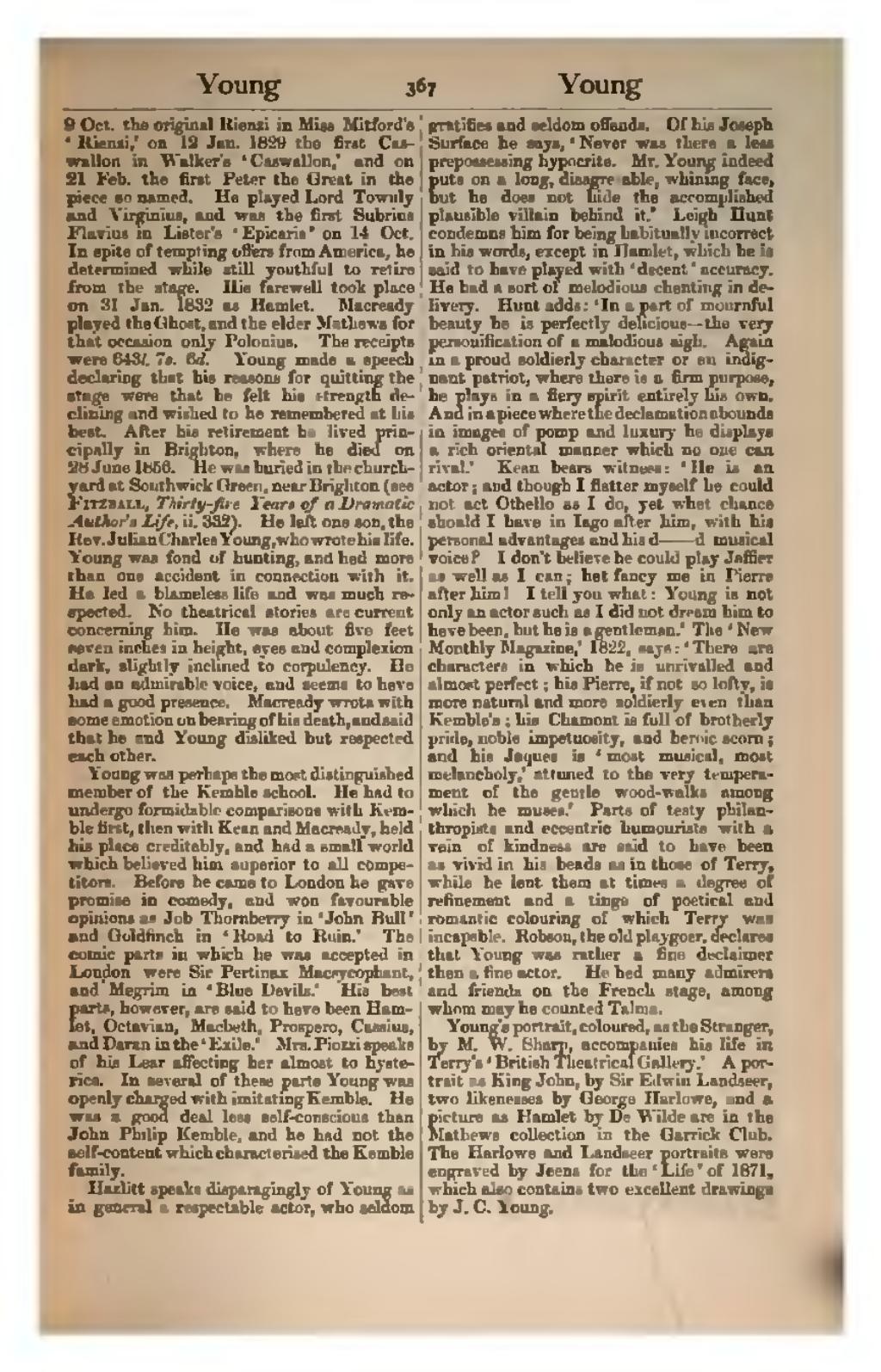9 Oct. the original Rienzi in Miss Mitford's ‘Rienzi,’ on 12 Jan. 1829 the first Caswallon in Walker's ‘Caswallon,’ and on 21 Feb. the first Peter the Great in the piece so named. He played Lord Townly and Virginius, and was the first Subrius Flavius in Lister's ‘Epicaris’ on 14 Oct. In spite of tempting offers from America, he determined while still youthful to retire from the stage. His farewell took place on 31 Jan. 1832 as Hamlet. Macready played the Ghost, and the elder Mathews for that occasion only Polonius. The receipts were 643l. 7s. 6d. Young made a speech declaring that his reasons for quitting the stage were that he felt his strength declining and wished to be remembered at his best. After his retirement he lived principally in Brighton, where he died on 28 June 1856. He was buried in the churchyard at Southwick Green, near Brighton (see Fitzball, Thirty-five Years of a Dramatic Author's Life, ii. 332). He left one son, the Rev. Julian Charles Young, who wrote his life. Young was fond of hunting, and had more than one accident in connection with it. He led a blameless life and was much respected. No theatrical stories are current concerning him. He was about five feet seven inches in height, eyes and complexion dark, slightly inclined to corpulency. He had an admirable voice, and seems to have had a good presence. Macready wrote with some emotion on hearing of his death, and said that he and Young disliked but respected each other.
Young was perhaps the most distinguished member of the Kemble school. He had to undergo formidable comparisons with Kemble first, then with Kean and Macready, held his place creditably, and had a small world which believed him superior to all competitors. Before he came to London he gave promise in comedy, and won favourable opinions as Job Thornberry in ‘John Bull’ and Goldfinch in ‘Road to Ruin.’ The comic parts in which he was accepted in London were Sir Pertinax Macsycophant, and Megrim in ‘Blue Devils.’ His best parts, however, are said to have been Hamlet, Octavian, Macbeth, Prospero, Cassius, and Daran in the ‘Exile.’ Mrs. Piozzi speaks of his Lear affecting her almost to hysterics. In several of these parts Young was openly charged with imitating Kemble. He was a good deal less self-conscious than John Philip Kemble, and he had not the self-content which characterised the Kemble family.
Hazlitt speaks disparagingly of Young as in general a respectable actor, who seldom gratifies and seldom offends. Of his Joseph Surface he says, ‘Never was there a less prepossessing hypocrite. Mr. Young indeed puts on a long, disagreeable, whining face, but he does not hide the accomplished plausible villain behind it.’ Leigh Hunt condemns him for being habitually incorrect in his words, except in Hamlet, which he is said to have played with ‘decent’ accuracy. He had a sort of melodious chanting in delivery. Hunt adds: ‘In a part of mournful beauty he is perfectly delicious—the very personification of a melodious sigh. Again in a proud soldierly character or an indignant patriot, where there is a firm purpose, he plays in a fiery spirit entirely his own. And in a piece where the declamation abounds in images of pomp and luxury he displays a rich oriental manner which no one can rival.’ Kean bears witness: ‘He is an actor; and though I flatter myself he could not act Othello as I do, yet what chance should I have in Iago after him, with his personal advantages and his d——d musical voice? I don't believe he could play Jaffier as well as I can; but fancy me in Pierre after him! I tell you what: Young is not only an actor such as I did not dream him to have been, but he is a gentleman.’ The ‘New Monthly Magazine,’ 1822, says: ‘There are characters in which he is unrivalled and almost perfect; his Pierre, if not so lofty, is more natural and more soldierly even than Kemble's; his Chamont is full of brotherly pride, noble impetuosity, and heroic scorn; and his Jaques is ‘most musical, most melancholy,’ attuned to the very temperament of the gentle wood-walks among which he muses.’ Parts of testy philanthropists and eccentric humourists with a vein of kindness are said to have been as vivid in his hands as in those of Terry, while he lent them at times a degree of refinement and a tinge of poetical and romantic colouring of which Terry was incapable. Robson, the old playgoer, declares that Young was rather a fine declaimer than a fine actor. He had many admirers and friends on the French stage, among whom may be counted Talma.
Young's portrait, coloured, as the Stranger, by M. W. Sharp, accompanies his life in Terry's ‘British Theatrical Gallery.’ A portrait as King John, by Sir Edwin Landseer, two likenesses by George Harlowe, and a picture as Hamlet by De Wilde are in the Mathews collection in the Garrick Club. The Harlowe and Landseer portraits were engraved by Jeens for the ‘Life’ of 1871, which also contains two excellent drawings by J. C. Young.
